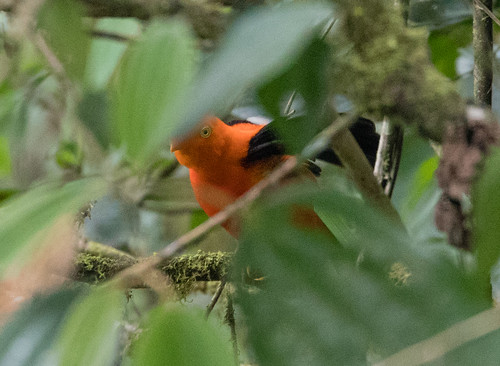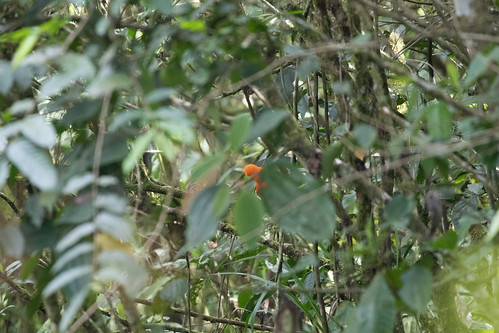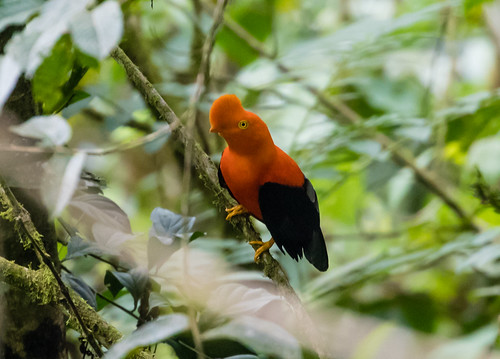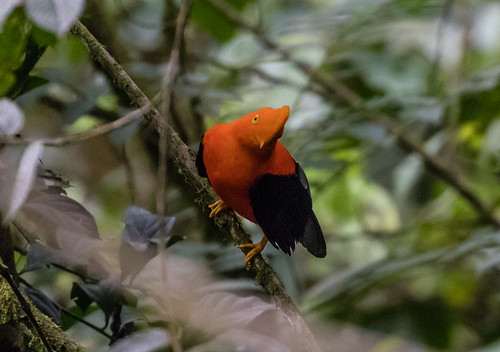When I was a teacher in the late 70s, one of my students was
fixated on the Andean Cock-of-the-rock, the national bird of Peru. The funky
males are an improbably glowing orange or red on their head, back, and
underside, with shiny black wings and tail, and rectangular, soft- gray scapular
feathers running down the edge of their wings in the center of their back. The
forward-sloping rounded crest, on both sexes, virtually covers the small bill
and gives the head an oddly bulging shape. The glittering white iris forms a
perfect circle around the black pupil, all surrounded by that lovely tropical
orange.
I’d been birding for a few years back when I was a teacher,
but I’d certainly never seen a cock-of-the-rock, and had no more concept of
Peru than that Michael Bond’s sweet Paddington Bear came from deepest, darkest
Peru. As I got more into birding and started learning about birds from beyond
North America, I started wishing I could see a cock-of-the-rock myself, but it
seemed improbable at best that I’d ever make it to Peru.
But in late July, I was asked to go to Peru for a week on a
“fam tour”—I’d be shown several of the top birding spots in northern Peru with
the assignment of writing about them. My very first thought was—was it possible
I’d see an Andean Cock-of-the-rock there? I received an itinerary a few weeks
ago, and instantly saw that it wasn’t listed as a target species. When I went
through the eBird checklists for the places we’d be going to, it was listed on
two of the checklists, but I realized that meant my chances were poor at
best—the sightings from there might have been in the wrong season or the bird
just too rare or too shy for an easy sighting with a group.
The cock-of-the-rock is an extremely secretive bird of a highly
endangered habitat—tropical cloud forest. One of the most important dangers
facing cloud forests in South and Central America is that the clouds are
dwindling. Between the heat and droughts associated with climate change and the
massive destruction of the forests, the land is warming, the clouds above it
dissipating.
Other species associated with cloud forest, such as the
Resplendent Quetzal and many trogons, toucans, and hummingbirds, are also
dwindling. I tried not to get my hopes up about seeing a cock-of-the-rock, but
that is of course easier said than done.
But last Tuesday, September 6, on our drive between two
birding lodges, our guide Wilson Diaz (from Green Tours) told the bus driver to stop in a spot that looked
pretty much like every other stretch of that mountain road, and we piled out.
He started down the road a short ways, me scanning the forest floor on the
downslope, when what to my wondering eyes should appear but a brilliant orange
blob of color hurling through a tiny opening in the trees. It was the briefest
of sightings, and I didn’t even see the shape of a bird—for all I knew for sure,
it could have been someone tossing away a rather large bowl of orange sherbet.
But there is nothing else that color that occurs naturally there, so we stopped
and scrutinized.
After just a few minutes, someone spotted a female Andean
Cock-of-the-Rock, and soon we noticed a second one, lurking in the shadows far
below us.
And then, what to our wondering eyes should appear but a glorious
male. He was mostly hidden by foliage—even with a spotting scope, it took
minutes before anyone could see his glittering eye and funky crest.
Conditions
were horrible for photography—the forest was dark, and the bird so far away
that he was hard to locate in the camera viewfinder, much less to actually
focus on. But I got took hundreds of photos, refocusing over and over hoping
that a few would turn out. And suddenly he fluttered over a couple of branches,
and for a few glorious minutes we had him in full view. Photography was still
tricky with the low light and distance. About sixty percent of my photos didn’t
turn out at all, but of the ones that did, thanks to the miracle of Adobe
Lightroom, a few look pretty darned good, at least as memories of a magical moment.
After my heart attack last year, I’ve pretty much scaled
back my hopes and dreams for what I can do and see and hear in my remaining
years. Just being in Peru, walking on ground that I knew cocks-of-the-rock had
also walked upon, breathing air molecules that had been breathed by
cocks-of-the-rock was wonderful enough. Spotting an orange blob hurtling
through the air was wonderful enough. Seeing females in the shadows was
wonderful enough. Seeing pieces of the male behind the foliage was wonderful
enough. Actually feasting my eyes on this beautiful bird in full view for many
minutes was a greater gift than I could have dreamed of—one that will stay with
me every day I’m given on this beautiful earth.






